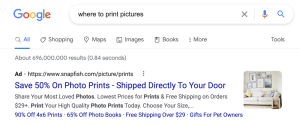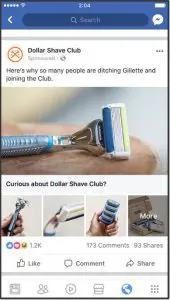
Top 3 PPC Marketing Services For Business Growth
You may or may not have noticed that marketing loves its acronyms – CTA, SEO, UI/UX, B2B, the list goes on. Pay-per-click, or PPC, may be just another acronym to memorize, but it’s worth a deep dive if you’re serious about growing your brand. At Savy, we’ve implemented successful PPC marketing services since their inception. Here are our top three and how they can benefit your business.
PPC Marketing Services: An Overview
Step back in time with us to the early years of the Internet. The year is 1996 and Planet Oasis, a virtual city for Web exploration, creates a web app with sponsored businesses “paying per click on their respective logos to launch company websites.” It’s a novel idea, but one that also makes sense. Why pay to advertise if people aren’t engaging with your content? Since, of course, every click is a potential conversion.
After this scenario, the idea of PPC and strategic web advertising started to gain momentum. Open Text proposed bids for keywords, Goto.com launched a PPC ad model, and in 1999 Google started search advertising. Since then, PPC has become more complex and competitive yet remains a valuable tool for advertisers and brands looking to get noticed by consumers.
Main Benefits
Before signing on for PPC marketing services with your agency, it’s good to do your research on the main benefits. The most obvious benefit is that you only pay when people click on your content, making it a cost-effective marketing tool. Not only that, but you can use demographic targeting with PPC, which means your content lands in front of those most likely to click and convert in the first place. Lastly, PPC and SEO work together, which means if you’ve spent time developing and implementing your keyword strategy, your PPC will be more effective and your brand more noticed.
What Makes Up a Successful PPC Campaign
Even if a digital marketing agency implements PPC advertising services for your brand, you should still understand what makes a successful campaign. When explaining these services to clients, we first outline that PPC operates under a bidding model. This means that your brand is competing with others against high-volume keywords that, ideally, your consumers will search. The bottom line is, the more you’re willing to pay for each of those clicks, the more your content will be seen (and prioritized by search engines). So how do you know which terms to bid on? By having a thoughtful keyword strategy that includes key terms for your brand, long-tail keywords, transactional keywords (“for sale”), and location keywords (“near me”).
Then, of course, you need a place for the clicks to land. While this could be your website homepage, it’s not always the most strategic decision. Creating a specific landing page for users to click to that’s customized to their search inquiry will help legitimize the click and lead to interest and conversions. Lastly, the content of the ads themselves should be actionable, intriguing, relevant, and understandable.
That said, these are the top three PPC marketing services that we recommend and offer.
Search Ads
Search ads are the most common way brands can do PPC. SEM, or search engine marketing, refers to digital ads placed via search engines like Google or Yahoo. Search ads are the number one type of PPC funnel we recommend when growing your business, given their potential for brand awareness and conversions. For search ads, you would need all the elements described in the above section but tailored to a search engine. As a top-performing Google Partner, we’ll use them as an example. The keywords chosen in this phase are of the utmost importance because, if done right, they should reflect potential customers’ queries (i.e., what people type into a search bar).
This search ad from Snapfish is a great example of one that’s both highly actionable and timely. The “where to print pictures” term brings the relevant ad to its users, and its top location on Google means it’s hard to ignore.
The overall goal of search ads is to get your users’ attention where they’re most likely to click and convert. In the case of the Snapfish ad, that was when they were in the buying process with a clear goal and product/service in mind. By understanding your unique brand goals and setting intentions (and correct keywords) for a search ad, your brand is better positioned to grow.
Social Ads
If a brand isn’t on social media in some capacity these days, the answer is always “why,” followed by a skeptical look and, often, some distrust (we don’t make the rules). So a natural extension of a social presence is entering the social ad game. PPC ads on platforms like Facebook, Instagram, and LinkedIn offer a great way for brands to grow their presence, connect with new audiences, and showcase products or services in a new light.
Because of the highly personalized nature of social media, PPC marketing services for these platforms also need to be personal. In other words, something that looks like a billboard ad created for random passersby will probably repel the clicks. Facebook, for example, allows for native ads that blend seamlessly into users’ feeds. It also allows for more strategic targeting by location, interests, and demographics. Take this Dollar Shave Club Facebook ad. Its simple (somewhat cheeky) copy and design resulted in a one-and-a-half increase in subscriptions. The brand knew where its audience would be and what products they were already using. Facebook simply provided the perfect setting.
When marketing in an always-evolving environment like social media, you must know your brand goals and target audience(s) beforehand. You may have tons of clicks, but do those clicks matter? Are they the people that will actually buy your product? Likewise, you may have relatively low clicks, but all of them could be interested buyers and result in a sale. The bottom line? A truly effective PPC ad doesn’t forget strategy for creativity (and vice versa).
Display Ads
You’ve probably been scrolling a site or searching on Google when you’ve noticed an ad to the side or middle of the content. Maybe it’s even caught you off guard because you’d only been thinking about the content a day ago, and now here it is right in front of you (and annoyingly relevant). These are display ads. Often, these ads are more image-forward with some strategic and intriguing copy and frequently appear on Google partner websites.
To make these ads, you still need to bid on a keyword, but you ultimately need Google’s approval on the copy. Often, though, these ads are more cost-effective than their search PPC counterparts because there’s less competition. And though they can do a good job reaching people where they’re already looking (think: an ad for KitchenAid on a food blog), they are somewhat easier for users to ignore or skim over. This ad from Merrell does a great job of selling an experience via a product and connecting with their target audience’s love for simple, clean imagery and adventurous spirit.
Whether creating a display ad for a Google partnered site or a product display on Amazon, clicks are more likely to happen when the ad is simple, relevant to the target audience, has a clear CTA, and is attention-grabbing without being spammy.
PPC Marketing Services Since the Beginning
At Savy, we have over two decades of providing strategic PPC marketing services, including SEM and integrated marketing campaigns. We ground our approach in data and use this to create strategic, customized, and timely actions for our clients. With real-world experience and the ROIs to back it up, what is your brand waiting for?
Recent Posts
How to Rebrand Your Instagram for Better Engagement and Brand Recognition
Your Instagram presence can act as a beacon for brand recognition and customer engagement. It’s about painting a picture so compelling that your audience cannot help but be drawn to […]
Read MoreFrom Clicks to Conversions: The Science of High-Performing Digital Ads
The journey from interest to purchase is often paved with digital advertisements. However, not all digital ads are crafted equally. While some fade into the background, others command attention and […]
Read MoreBrand Consistency Examples That Will Make You Rethink Your Marketing Strategy
A consistent and strategic brand identity across all platforms is not just beneficial; it’s essential. By exploring real-world brand consistency examples, we uncover the immense power of maintaining a coherent […]
Read More3 Ways to Transform Blogs With SEO and Make Google Love Your Content
As marketers and business owners, our goal is to ensure the blogs we publish confidently stride into the spotlight of Google’s top search results. Achieving this requires great content, but […]
Read More






